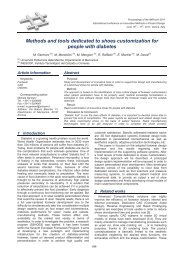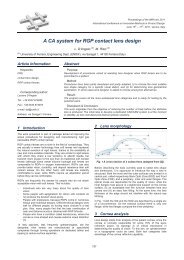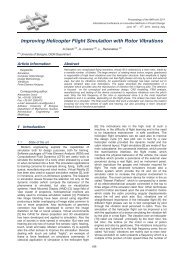New CAD/CAM process: an elaboration of the ... - IMProVe2011
New CAD/CAM process: an elaboration of the ... - IMProVe2011
New CAD/CAM process: an elaboration of the ... - IMProVe2011
Create successful ePaper yourself
Turn your PDF publications into a flip-book with our unique Google optimized e-Paper software.
M. Giord<strong>an</strong>o et al. <strong>New</strong> <strong>CAD</strong>/<strong>CAM</strong> <strong>process</strong>: <strong>an</strong> <strong>elaboration</strong> <strong>of</strong> <strong>the</strong> geometrical matrices <strong>of</strong> rosette<br />
The module on <strong>the</strong> grid takes <strong>an</strong>y <strong>of</strong> <strong>the</strong> following<br />
tr<strong>an</strong>sformations or combinations: identity, tr<strong>an</strong>slation,<br />
rotation around a point, reflection (or simply symmetry) on<br />
a line <strong>an</strong>d glide reflection [4].<br />
2 Method <strong>an</strong>d result. Geometry <strong>of</strong> rosette<br />
The rosette here presented is in Salerno’s Ca<strong>the</strong>dral <strong>of</strong><br />
Mat<strong>the</strong>w <strong>the</strong> Apostle, Italy.<br />
The church was built between 1080-1085; it has a Latin<br />
cross pl<strong>an</strong> <strong>an</strong>d <strong>an</strong> external colonnade whose columns are<br />
topped by round arches decorated with inlaid pilaster strip<br />
<strong>of</strong> volc<strong>an</strong>ic rock. Columns on <strong>the</strong> docks <strong>an</strong>d superb<br />
examples <strong>of</strong> rosette, yellow <strong>an</strong>d different black tuff, give<br />
more vitality to <strong>the</strong> whole.<br />
The rosette selected belongs to <strong>the</strong> dihedral group <strong>an</strong>d<br />
has twelve lines <strong>of</strong> symmetry. This determines a grid where<br />
it is possible to see two modules (fig. 1 <strong>an</strong>d fig. 2).<br />
Fig. 1 Rosette <strong>of</strong> Salerno´s Ca<strong>the</strong>dral with symmetry axis.<br />
Using <strong>the</strong> tool McNeel Rhinoceros 4.0 1 to rebuild <strong>the</strong><br />
module, considering only one <strong>of</strong> <strong>the</strong>m, it has been chosen<br />
<strong>the</strong> one in red. Next, detailed as obtained in fig. 2 <strong>an</strong>d<br />
consequently fig. 5.<br />
1 Please note that we are using <strong>the</strong> Itali<strong>an</strong> version <strong>of</strong> <strong>the</strong><br />
Rhinoceros 4.0SR8, that is why <strong>the</strong> names <strong>of</strong> <strong>the</strong> tools are in<br />
Itali<strong>an</strong>.<br />
Fig. 2 Schematically, two possible modules <strong>of</strong> rosette.<br />
In <strong>the</strong> reconstruction <strong>of</strong> <strong>the</strong> module, <strong>the</strong> gold ratio has<br />
been found to use it in <strong>the</strong> design <strong>of</strong> rosette. In each<br />
segment are <strong>the</strong> radii <strong>of</strong> <strong>the</strong> circles <strong>of</strong> rosette remains,<br />
considering <strong>the</strong> golden ratio: Ø ≈ 1.6180339887.<br />
The proportions as shown in eq. 1:<br />
Ox/ OE OC/<br />
Ox OB/<br />
OC OA/<br />
OB 1.618<br />
(1)<br />
note that <strong>the</strong> circle whose radius is Ox, is not used<br />
constructively in <strong>the</strong> rosette.<br />
Fig. 3 Golden ratio <strong>of</strong> rosette.<br />
Given this scheme <strong>of</strong> proportions (fig. 3) <strong>an</strong>d <strong>the</strong> grid<br />
(fig. 1), reconstruct <strong>the</strong> V-shaped motif with 72º <strong>an</strong>gle<br />
resting on <strong>the</strong> circle <strong>of</strong> radius OA. This <strong>an</strong>gle is<br />
determined by <strong>the</strong> relationship between <strong>the</strong> golden ratio<br />
<strong>an</strong>d <strong>the</strong> study <strong>of</strong> <strong>the</strong> Pentagon [5]. In it <strong>the</strong> tri<strong>an</strong>gle<br />
aureus, has internal <strong>an</strong>gles <strong>of</strong> 36º, 72º <strong>an</strong>d 72º. The<br />
reason is <strong>the</strong>n repeated in <strong>the</strong> circle <strong>of</strong> radius OB.<br />
In fig. 4 is shown <strong>the</strong> circles <strong>of</strong> radius OA , OB,<br />
OC,<br />
OE .<br />
Fig. 4 Motif <strong>an</strong>d module <strong>of</strong> rosette.<br />
The entire composition is generated by <strong>the</strong> operation <strong>of</strong><br />
“Serie polare” which specifies <strong>the</strong> center <strong>of</strong> rosette as a<br />
center <strong>of</strong> rotation, it is determined that <strong>the</strong>re are 12 items<br />
(includes a base module) <strong>an</strong>d is distributed through 360º.<br />
This distributes <strong>the</strong> module into <strong>the</strong> grid.<br />
The motive, <strong>the</strong> module, <strong>the</strong> grid <strong>an</strong>d tr<strong>an</strong>sformation by<br />
rotation is built geometrical matrix <strong>of</strong> rosette (fig. 5).<br />
June 15th – 17th, 2011, Venice, Italy<br />
441<br />
Proceedings <strong>of</strong> <strong>the</strong> IMProVe 2011










